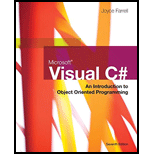
(a)
Program Plan:
- IDNumber, Make, Year, Price, autoId, autoMake, autoYear, autoPriceand temp2 variables are used in the program.
- ToString (),TryParse (), Any (), Add (), Sum (), Sort (),CompareTo (),andJoin () methods are used in the program.
Program Description: The main purpose of the program is to prompt the user to enter the data for the eight Automobile class objects. Create an Automobile class with the auto-implemented properties for the instance variable named IDNumber, make, year, and price. Return all the data of the Automobile class using the ToString () method. Sort the objects of the Automobile class in the IDNumber order.
(b)
Program Plan:
- IDNumber, Make, Year, Price, autoId, auto Make, auto Year, auto Price, Financed Amount, Interest Rate, autoFinAm,and auto IR variables are used in the program.
- ToString (),TryParse (), Any (), Add (), Sum (), Sort (),CompareTo (),andJoin() methods are used in the program.
Program Description: The main purpose of the program is to drive a new class named Financed Automobile from the base class named AutoMobile. Incude two extra instance variable in the Financed Automobile class to store the financed amount and interest rate of an Automobile. Create the auto-implemented properties for the financed amount and interest rate variable. Override the ToString () method of the AutoMobile class in the Financed Automobile class to display the value of financed amount and interest rate of an Automobile. Prompt the user to enter the details off our Financed Automobile class objects. The financed amount must be less than the price of an Automobile. Return all the data of the Automobile class using the ToString () method. Sort the objects of the Automobile class in the ID Number order.Display the total of the price of all the Automobiles.Display the total of the financed amount of all the Automobiles.
(c)
Program Plan:
- IDNumber, Make, Year, Price, autoId, autoMake, autoYear, autoPrice, FinancedAmount, InterestRate, autoFinAm,andautoIRvariables are used in the program.
- ToString (),TryParse (), Any (), Add (), Sum (), Sort (),CompareTo (),Join (), andstring.Format()methods are used in the program.
Program Description:The main purpose of the program is to use an extension method for the class named FinancedAutomobile. This method is used to compute and return the monthly due payment of a FinancedAutomobile. Prompt the user to enter the details of four FinancedAutomobile class objects. Display all the data of all four objects.
Trending nowThis is a popular solution!

Chapter 10 Solutions
Microsoft Visual C#
- Need help with coding in this in python!arrow_forwardIn the diagram, there is a green arrow pointing from Input C (complete data) to Transformer Encoder S_B, which I don’t understand. The teacher model is trained on full data, but S_B should instead receive missing data—this arrow should not point there. Please verify and recreate the diagram to fix this issue. Additionally, the newly created diagram should meet the same clarity standards as the second diagram (Proposed MSCATN). Finally provide the output image of the diagram in image format .arrow_forwardPlease provide me with the output image of both of them . below are the diagrams code make sure to update the code and mentionned clearly each section also the digram should be clearly describe like in the attached image. please do not provide the same answer like in other question . I repost this question because it does not satisfy the requirment I need in terms of clarifty the output of both code are not very well details I have two diagram : first diagram code graph LR subgraph Teacher Model (Pretrained) Input_Teacher[Input C (Complete Data)] --> Teacher_Encoder[Transformer Encoder T] Teacher_Encoder --> Teacher_Prediction[Teacher Prediction y_T] Teacher_Encoder --> Teacher_Features[Internal Features F_T] end subgraph Student_A_Model[Student Model A (Handles Missing Values)] Input_Student_A[Input M (Data with Missing Values)] --> Student_A_Encoder[Transformer Encoder E_A] Student_A_Encoder --> Student_A_Prediction[Student A Prediction y_A] Student_A_Encoder…arrow_forward
- Why I need ?arrow_forwardHere are two diagrams. Make them very explicit, similar to Example Diagram 3 (the Architecture of MSCTNN). graph LR subgraph Teacher_Model_B [Teacher Model (Pretrained)] Input_Teacher_B[Input C (Complete Data)] --> Teacher_Encoder_B[Transformer Encoder T] Teacher_Encoder_B --> Teacher_Prediction_B[Teacher Prediction y_T] Teacher_Encoder_B --> Teacher_Features_B[Internal Features F_T] end subgraph Student_B_Model [Student Model B (Handles Missing Labels)] Input_Student_B[Input C (Complete Data)] --> Student_B_Encoder[Transformer Encoder E_B] Student_B_Encoder --> Student_B_Prediction[Student B Prediction y_B] end subgraph Knowledge_Distillation_B [Knowledge Distillation (Student B)] Teacher_Prediction_B -- Logits Distillation Loss (L_logits_B) --> Total_Loss_B Teacher_Features_B -- Feature Alignment Loss (L_feature_B) --> Total_Loss_B Partial_Labels_B[Partial Labels y_p] -- Prediction Loss (L_pred_B) --> Total_Loss_B Total_Loss_B -- Backpropagation -->…arrow_forwardPlease provide me with the output image of both of them . below are the diagrams code I have two diagram : first diagram code graph LR subgraph Teacher Model (Pretrained) Input_Teacher[Input C (Complete Data)] --> Teacher_Encoder[Transformer Encoder T] Teacher_Encoder --> Teacher_Prediction[Teacher Prediction y_T] Teacher_Encoder --> Teacher_Features[Internal Features F_T] end subgraph Student_A_Model[Student Model A (Handles Missing Values)] Input_Student_A[Input M (Data with Missing Values)] --> Student_A_Encoder[Transformer Encoder E_A] Student_A_Encoder --> Student_A_Prediction[Student A Prediction y_A] Student_A_Encoder --> Student_A_Features[Student A Features F_A] end subgraph Knowledge_Distillation_A [Knowledge Distillation (Student A)] Teacher_Prediction -- Logits Distillation Loss (L_logits_A) --> Total_Loss_A Teacher_Features -- Feature Alignment Loss (L_feature_A) --> Total_Loss_A Ground_Truth_A[Ground Truth y_gt] -- Prediction Loss (L_pred_A)…arrow_forward
 EBK JAVA PROGRAMMINGComputer ScienceISBN:9781337671385Author:FARRELLPublisher:CENGAGE LEARNING - CONSIGNMENTProgramming Logic & Design ComprehensiveComputer ScienceISBN:9781337669405Author:FARRELLPublisher:Cengage
EBK JAVA PROGRAMMINGComputer ScienceISBN:9781337671385Author:FARRELLPublisher:CENGAGE LEARNING - CONSIGNMENTProgramming Logic & Design ComprehensiveComputer ScienceISBN:9781337669405Author:FARRELLPublisher:Cengage Microsoft Visual C#Computer ScienceISBN:9781337102100Author:Joyce, Farrell.Publisher:Cengage Learning,
Microsoft Visual C#Computer ScienceISBN:9781337102100Author:Joyce, Farrell.Publisher:Cengage Learning, EBK JAVA PROGRAMMINGComputer ScienceISBN:9781305480537Author:FARRELLPublisher:CENGAGE LEARNING - CONSIGNMENT
EBK JAVA PROGRAMMINGComputer ScienceISBN:9781305480537Author:FARRELLPublisher:CENGAGE LEARNING - CONSIGNMENT Programming with Microsoft Visual Basic 2017Computer ScienceISBN:9781337102124Author:Diane ZakPublisher:Cengage Learning
Programming with Microsoft Visual Basic 2017Computer ScienceISBN:9781337102124Author:Diane ZakPublisher:Cengage Learning




